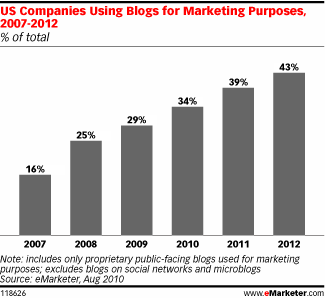Marketers relying more on blogs in the business world
 Although Facebook and Twitter are highly rated from internet consumers, blogs are the standard approach for marketers in the business world (b2b).
Although Facebook and Twitter are highly rated from internet consumers, blogs are the standard approach for marketers in the business world (b2b).
eMarketer just released a study that states 34% of all US companies are running a public blog. The outlook for 2012 is even more promissing: The study projects an increase by 11 points to a total of 45% by 2012. In 2007 only 16% of companies used a blog for their communication strategy.
“Studies have shown that marketers perceive blogs to have the highest value of any social media in driving site traffic, brand awareness, lead generation and sales—as well as improving customer service.” Paul Verna, senior analyst, eMarketer
Especially smaller companies with less marketing bucks see the potential of blogs. Short sign-of processes, faster internal dynamics and more flexibility in choosing social technology make it easier for a managing director of an SMB company to set up a blog. Larger companies like stock listed companies have more restricted options to go live on WordPress, Blogger or Typepad in terms of potential legal, IR-related and logistical issues.
Though Twitter and Facebook are easier to set up and kick off the conversation with clients, the impact of blogs is manifold. Blog posts are indexable and searchable on Google as well as on other search engines. And blogging has a long-lasting effect. While tweets cannot talk about complex topics and disappear quite quickly from search engines, blog post stay – no matter if you are looking for that information today ot in five years time.
Spot On!
If companies can manage it from a resources perspective, the best way to go forward is to set up many social media access points. The professionals have identified by web analysis and social media monitoring where client engagement takes place and where their clients are talking. In a perfect world, users will find the blog post via Twitter and then use the “Like” button to get to the Facebook page – and ideally find some interesting and relevant content there again. But creating different content for different access points is the biggest challenge…, bigger than writing a blog post. Don’t you think…?


